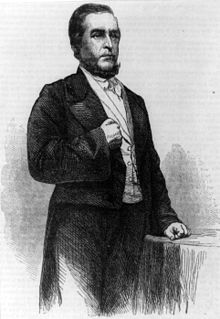Juan Rafael Mora Porras
Juan Rafael Mora Porras (born February 8, 1814 in San José , † September 30, 1860 in Puntarenas ) was President of Costa Rica from November 26, 1849 to August 14, 1859 .
Life
His parents were Ana Benita Porras y Ulloa and Camilo Mora y Alvarado.
He was a member of the Partido Liberal . In 1837 he was mayor of San José and sold communal real estate through his brokerage office with considerable price increases. He had coffee and sugar cane grown on his latifundia.
In 1847 he was appointed deputy president José María Castro Madriz and in 1848 dismissed from the deputy. In 1849 he was appointed Deputy President José María Castro Madriz . A coup threat from General José Manuel Quirós y Blanco urged José María Castro Madriz to resign to José Miguel Mora Porras on November 16 . José Miguel Mora Porras passed the office on to his brother Juan Rafael on November 26, 1849. Juan Rafael was later confirmed in this office by parliament.
During his tenure, the independence of Costa Rica was recognized by the former colonial power Spain. Pope Pius IX decreed the formation of the diocese of Costa Rica in 1850 and appointed Anselmo Llorente y Lafuente its bishop.
In 1851 there was street lighting in San José. A building was erected for the Universidad de Santo Tomás . Mora had a state-owned Fábrica Nacional de Licores built for its sugar production . Ingeniero Nicolás Gallegos designed the first city map of San José.
In 1853 he was re-elected.
He had the road from Cartago to Puerto de Puntarenas expanded. The road accelerated the economic development of Costa Rica.
Mora Porras was one of the first to recognize the danger posed by William Walker and the filibusters to Central America and, from the beginning of 1856, had it resolutely fought.
In the first phase of the war, he passed his presidency to his deputy, Francisco María Oreamuno , and commanded the troops of Costa Rica victoriously in the Battle of Santa Rosa , the Battle of Sardianal and the First Battle of Rivas .
The Costa Rican troops brought from Nicaragua the cholera with that demanded in Costa Rica 10,000 victims, almost a tenth of the population at that time.
The war against the Filibusteros continued in 1857 after Máximo Blanco had succeeded in a campaign on the Río San Juan to bring this under control of Costa Rica and thus cut off the Filibusteros from supplies from the industrialized east coast of the USA.
Juan Rafael Mora Porras signed contracts with the British adventurer William Webster over an inter-oceanic route, which was rejected in Nicaragua, whose government under Máximo Jerez Tellería declared war on Costa Rica in 1857.
On April 15, 1858, Tellería signed the Tratado Cañas-Jerez on the border between the two countries as an agent in Costa Rica . The agent for Costa Rica was José María Cañas Escamilla. Costa Rica did not get access to Lake Nicaragua but the right of way on the Río San Juan.
After Mora was re-elected for a third term in early 1859, the commander of the San José garrison overthrew him in a coup on August 14, 1859. He was forced to leave the country and settled in El Salvador.
In the elections in 1860, the Partido Liberal nominated his relative Manuel Mora Fernández as a presidential candidate. José María Montealegre Fernández became president . He tried to find an agreement with Juan Rafael Mora Porras and persuade him to renounce power, but these efforts brought no result.
Juan Rafael Mora Porras disembarked in the port of Puntarenas in September 1860 with a few friends and relatives - under the illusion that his appearance would trigger an uprising in his favor. The government of Montealegre sent troops to meet him. The Moranistas were defeated in a battle in La Angostura. Mora was captured and sentenced to death by a court martial. He was fused with General Cañas on September 30, 1860 in Puntarenas . His remains rest on the Cementerio General of San José.
Personal
Mora Porras' siblings were
- Ana María Mora Porras, the wife of José María Montealegre Fernández
- Guadalupe Mora Porras, the wife of General José María Cañas Escamilla
- José Miguel Mora Porras
- General José Joaquín Mora Porras
On June 24, 1847, he married Inés Aguilar, daughter of Manuel Aguilar Chacón, in San José Cueto . Seven children were born in this marriage: Elena, Teresa, Alberto, Amelia, Juan de Dios, Camilo and Juana Mora Aguilar.
Remarks
- ^ Es : José Manuel Quirós y Blanco
- ^ Es : Batalla de Santa Rosa (Costa Rica)
- ^ Es : Batalla de Rivas
- ^ Es : Máximo Blanco
- ^ Es : Tratado Cañas-Jerez
- ^ Es : Manuel Mora Fernández
- ^ Es : José María Cañas Escamilla
literature
- Felipe Molina: Bosquejo de la Republica de Costa Rica, seguido de apuntamientos par su historia. New York 1851
Individual evidence
- ^ Clotilde María Obregón: Nuestros gobernantes: Verdades del pasado para comprender el futuro . Editorial Universidad de Costa Rica, 2002, p. 10.
| predecessor | Office | successor |
|---|---|---|
| José Miguel Mora Porras |
Presidents of Costa Rica November 26, 1849 - August 14, 1859 |
José María Montealegre Fernández |
| personal data | |
|---|---|
| SURNAME | Mora Porras, Juan Rafael |
| BRIEF DESCRIPTION | President of Costa Rica |
| DATE OF BIRTH | February 8, 1814 |
| PLACE OF BIRTH | San Jose |
| DATE OF DEATH | September 30, 1860 |
| Place of death | Puntarenas |


